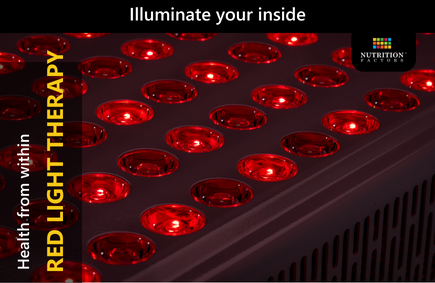Researchers have identified a key mechanism in red and near-infrared light therapy: these wavelengths can penetrate cells and activate the mitochondria (cell’s powerhouse). This activation increases cellular energy production.
Cytochrome C oxidase is a crucial component of the respiratory chain within our mitochondria, playing a pivotal role in ATP production. When exposed to red and near-infrared light, photons interact with cytochrome c oxidase, aiding mitochondria in using oxygen more efficiently to produce ATP.
Like human cells require nutrients from food, light is also essential for cellular function. Specific wavelengths of light can energize cells, influence hormones and neurotransmitters, maintain mood balance, enhance physical performance, alleviate stress, and improve sleep.
Electromagnet spectrum
The electromagnetic spectrum includes various types of electromagnetic radiation, ranging from gamma rays to radio waves. The visible light spectrum, seen by the human eye, spans wavelengths from 380 to 750 nanometers, creating the colors of the rainbow. Infrared radiation lies beyond the visible spectrum, with near-infrared (NIR) encompassing wavelengths from 750 to 1,400 nanometers. Red light, falling within the visible spectrum (620 to 750 nm), is part of sunlight. Red light therapy utilizes red and near-infrared wavelengths, with potential health benefits supported by research, including increased cellular energy production and improved blood flow.
Red light therapy has been studied for various potential health benefits, and while research is ongoing, some of the reported benefits include:
Improved Skin Health:
- Red light therapy may stimulate collagen production, promoting skin elasticity and reducing wrinkles.
- It may help with skin conditions such as acne, psoriasis, and eczema.
Pain Relief and Inflammation Reduction:
- Red light therapy has shown promise in reducing pain and inflammation in arthritis and other musculoskeletal disorders.
- It may aid in post-exercise recovery by reducing muscle soreness.
Wound Healing:
- The therapy may accelerate wound healing by promoting cell regeneration and tissue repair.
Enhanced Muscle Recovery:
- Athletes and individuals involved in physical training may benefit from red light therapy’s potential to speed up muscle recovery and reduce exercise-induced fatigue.
Improved Joint Health:
- Red light therapy may contribute to joint health by reducing inflammation and promoting the production of synovial fluid.
Cognitive Function:
- Some studies suggest that red light therapy may have neuroprotective effects and benefit cognitive function.
Mood and Sleep Regulation:
- Exposure to red light may influence the production of melatonin, a hormone that regulates sleep, and serotonin, a neurotransmitter associated with mood.
Hair Growth:
- Red light therapy has been investigated for its potential to stimulate hair growth in conditions like androgenetic alopecia.
Improved Circulation:
- Red light therapy may enhance blood flow, potentially aiding in better circulation and oxygenation of tissues.
When exposed to red and near-infrared light, photons interact with cytochrome c oxidase, aiding mitochondria in using oxygen more efficiently to produce ATP.
Like human cells require nutrients from food, light is also essential for cellular function. Specific wavelengths of light can energize cells, influence hormones and neurotransmitters, maintain mood balance, enhance physical performance, alleviate stress, and improve sleep.
Electromagnet spectrum
The electromagnetic spectrum includes various types of electromagnetic radiation, ranging from gamma rays to radio waves. The visible light spectrum, seen by the human eye, spans wavelengths from 380 to 750 nanometers, creating the colors of the rainbow. Infrared radiation lies beyond the visible spectrum, with near-infrared (NIR) encompassing wavelengths from 750 to 1,400 nanometers. Red light, falling within the visible spectrum (620 to 750 nm), is part of sunlight. Red light therapy utilizes red and near-infrared wavelengths, with potential health benefits supported by research, including increased cellular energy production and improved blood flow.
Red light therapy has been studied for various potential health benefits, and while research is ongoing, some of the reported benefits include:
Improved Skin Health:
- Red light therapy may stimulate collagen production, promoting skin elasticity and reducing wrinkles.
- It may help with skin conditions such as acne, psoriasis, and eczema.
Pain Relief and Inflammation Reduction:
- Red light therapy has shown promise in reducing pain and inflammation in arthritis and other musculoskeletal disorders.
- It may aid in post-exercise recovery by reducing muscle soreness.
Wound Healing:
- The therapy may accelerate wound healing by promoting cell regeneration and tissue repair.
Enhanced Muscle Recovery:
- Athletes and individuals involved in physical training may benefit from red light therapy’s potential to speed up muscle recovery and reduce exercise-induced fatigue.
Improved Joint Health:
- Red light therapy may contribute to joint health by reducing inflammation and promoting the production of synovial fluid.
Cognitive Function:
- Some studies suggest that red light therapy may have neuroprotective effects and benefit cognitive function.
Mood and Sleep Regulation:
- Exposure to red light may influence the production of melatonin, a hormone that regulates sleep, and serotonin, a neurotransmitter associated with mood.
Hair Growth:
- Red light therapy has been investigated for its potential to stimulate hair growth in conditions like androgenetic alopecia.
Improved Circulation:
- Red light therapy may enhance blood flow, potentially aiding in better circulation and oxygenation of tissues.
https://www.ncbi.nlm.nih.gov/pmc/articles/PMC7990011/
https://www.ncbi.nlm.nih.gov/pmc/articles/PMC5523874/

